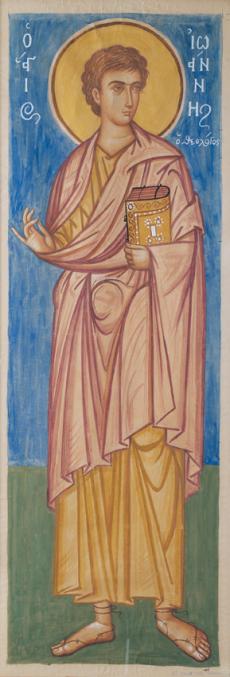


Fotis Kontoglou has become identified with modern religious painting in Greece, on which he left an indelible imprint. The personality and work of this artist from Asia Minor became a point of reference for the artists that came to be known as the Generation of the ‘30s. Up to date with contemporary movements, as he lived in Paris for a number of years, until 1919, Kontoglou remained committed to the pursuit of an authentic Greek style. Byzantine and folk painting, as well as the Fayum portraits, helped shape the style of his art. Mainly during the 1950s and 1960s, he produced portable icons and wall paintings for a large number of churches in and outside of Greece. Most likely made in 1953, the two works in the A. G. Leventis Foundation Collection are preliminary designs in tempera for stained-glass windows in the Church of the Holy Trinity (Agia Triada) in Charleston, USA. The slender figures – St John the Theologian in a chiton and himation, and St George as a warrior saint – echo Byzantine models, especially with respect to drawing, reflecting Kontoglou’s unwavering dedication to the iconographical tradition, while he chose to work in a soft, bright palette.
In 1913 he enrolled in the Athens School of Fine Arts, yet two years later he deferred his studies and eventually graduated in 1933. He travelled to various countries and lived in Paris until 1919, where he wrote the novel Pedro Cazas. He returned to Ayvali and taught in a high school; with the defeat of the Greek army in Asia Minor in 1922, he went to Mytilene as a refugee and then to Athens. In 1923 he travelled to Mount Athos to study Byzantine art. In the same year he held an exhibition jointly with Konstantinos Maleas and showed his work at the Lyceum Club of Greek Women in Athens. In 1932 he painted the fresco in his home (now in the National Gallery, Athens) and from 1937 to 1939 he created the history murals in Byzantine style for the Athens City Hall. He painted many churches, including the Kapnikarea in Athens (1942-1953), and portable icons and also worked as an art conservator during the 1930s. He participated in the Biennales of Venice (1934) and Alexandria (1957). He received the Academy of Athens Award for his two-volume book ????????, ????? ????????? ??? ???????? ????????? ??????????? [Expression, the history of Orthodox iconography] (1960) and the Award of Excellence in the Arts and Letters of the Academy of Athens (1965). With his expert knowledge of Byzantine painting and his study of earlier art, such as the Fayum portraits, he became a key advocate of the demand for an authentic Greek art. His contribution to the development of modern religious painting in Greece was decisive.